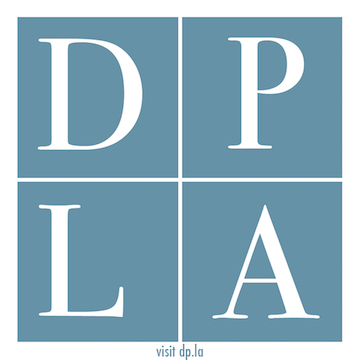by Russell Knapp, UW-Madison iSchool (2025)
This past semester, I had the pleasure of working with Middleton Area Historical Society (MAHS) as a part of the Recollection Wisconsin Digitization Initiative. My project included digitizing items held by MAHS that related to the history of the transportation and hospitality industries in the town of Middleton. This included digitizing and creating metadata for photographs, postcards, matchbook covers, restaurant menus, film negatives, slides, and more.
In the middle of the 19th century, Middleton was just a tiny town in the vicinity of Madison and west of Lake Mendota. But it would go on to develop an unusually large number of restaurants, hotels, bars, and liveries for its population size. At one point, the village of 200 permanent residents had five hotels. You might be wondering, how did such a small town develop such a thriving hospitality industry? To answer that question, a little historical context is needed.
In the mid-1800s, there was a concerted effort to connect the Great Lakes with the Mississippi River to allow for faster and easier trade. If this dream were met, the goods created in Michigan and the Great Lakes region, or even on the East Coast, could travel through Lake Michigan, across Wisconsin or Illinois, and down the Mississippi River, through cities like St. Louis, Memphis, and down to New Orleans. There were several attempts to achieve this by water, including a failed effort to connect Green Bay and the Fox River to the Mississippi, and a successful effort in Illinois that connected the Chicago and Illinois rivers via a canal, which opened in 1848. There was also an interest in connecting Lake Michigan to the Mississippi by railway.
In 1850, the Milwaukee and Mississippi Railroad (eventually known as “The Milwaukee Road”) began construction, which was an attempt to connect the port of Milwaukee on Lake Michigan with the Mississippi River. The railroad was built in incremental steps, finally meeting the Mississippi through a station in Prairie du Chien in 1857. Along the way, the railroad created numerous stations, and indeed, a station was built in Middleton.
Middleton Railroad Depot from the early 1900s.
Suddenly, Middleton was connected with the world of trade, and an influx of travellers arrived by various modes of transportation, for various purposes. By 1874, the railroad was also connected with Chicago and St. Paul, which allowed for even more visitors in Middleton along the route. To meet the demand of travellers, Middleton’s hospitality industry blossomed with numerous restaurants, hotels, bars, and more. Middleton continued to have thriving hospitality and transportation industries throughout the rest of the 19th and 20th centuries.


Items from Doc Teckam’s Tavern, which was open from 1923 to 1955.
Included in this digitization project were photos of various restaurants and bars in Middleton, as well as ephemeral items such as menus and match covers. One of my favorite aspects of this project was being able to learn about specific locations and how they changed over time. Many of the most historic locations that have photographs or other items in this collection are still standing today. I especially liked the ephemeral items digitized, such as match covers, especially if they were paired with photos from a particular location. Below is a match cover from Doc Teckam’s Tavern, paired with a fun photo of a dog from the interior of the tavern. Pairings like these make a historical setting come alive, so I was so glad to be able to digitize so many different types of items.
While working with, digitizing, and creating metadata for all these amazing historical items was fun, I also found myself inspired by the historical society. MAHS is completely volunteer-run, meaning that everyone who works there is passionate about the local history of their town. One of my on-site supervisors, Carolyn Mattern, was incredibly knowledgeable about Middleton’s history and was able to provide amazing historical descriptions about many of the locations that were depicted in the digitized items. My other on-site supervisor, Ruth Bachmeier, was passionate about getting MAHS’s items digitized, providing high-quality scans for the historical society, and online images that are accessible to the public.
I also had the opportunity to give a presentation about my project to the historical society board. They asked a lot of great questions, which also indicated their knowledge and passion for Middleton history. This was all quite inspiring, and I only hope I can be as passionate about preserving history in my future career as the MAHS members are. In addition, MAHS runs the Rowley House Museum which is open twice a week on Tuesdays (1pm-4pm) and Saturdays (10am-1pm). I highly recommend checking out the museum for anyone who lives near Madison or the Dane County area to see some great historical items in a historic house. If you need more convincing, you could make a day out of it by also checking out the National Mustard Museum, which is a short walk down the road, and the Hubbard Avenue Diner and Bakery to get some delicious pie or classic American diner food. If you go before the end of May, you could also stop by Middleton Public Library to see a display created by MAHS titled “The History We Carry,” which includes vintage purses and bags, suitcases, water bottles, and other carried items.
The Recollection Wisconsin Digitization Initiative brings together Wisconsin content partners and information school graduate students to create new digital collections. Content partners will choose collections to digitize, and student staff will handle the digitization, metadata work, and project documentation creation as part of a paid practicum or independent study experience. Most digitized collections will be added to Recollection Wisconsin throughout the year. Thanks to the State of Wisconsin for funding this important work. For more information about this Initiative, visit our program website.



You must be logged in to post a comment.